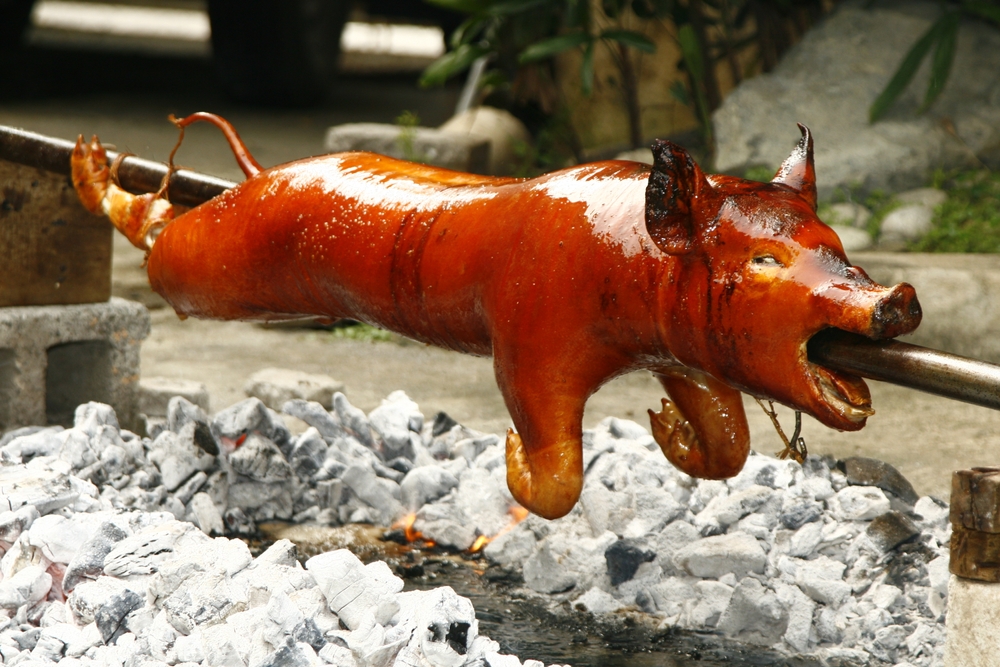Lechón (Spit-Roasted Suckling Pig)
Lechón, the Filipino spit-roasted suckling pig, is an iconic dish that represents celebration and festivity in Filipino culture. Known for its crispy, golden-brown skin and tender, juicy meat, lechón is prepared by rubbing a whole pig (inside and outside) with spices and stuffing it with lemongrass before a pair of pliers and heavy wire are used to stitch its cavity closed. The pig is skewered on a rotating spit and slow-roasted over hot charcoal for hours, allowing the skin to achieve a crackling crispiness while the meat remains flavorful and moist. Also known as rotisserie cooking, this labor-intensive method—which requires constant attention—gives lechón its signature rich and savory taste. It is traditionally served during large gatherings and special occasions, from birthdays to fiestas and weddings, often as the centerpiece of the feast. Typically accompanied by a dipping sauce of vinegar, liver sauce, or spiced vinegar, lechón is a beloved dish that showcases Filipino culinary expertise and the nation’s love for bold, celebratory flavors.
Recipe Servings: 10–12
Ingredients
- 1 or 2 bunches lemongrass
- 1 18-lb (8-kg) suckling pig
- 10 garlic cloves, crushed
- Coarse salt, to taste
- Ground black pepper, to taste
- 3 cups (750 ml) salt-reduced soy sauce
- 3 cups (750 ml) olive oil
Directions
- Trim off ends of lemongrass stalks and discard.
- Peel away tough outer layers of lemongrass stalks to reveal the pale lower section of the stem.
- Preheat charcoal until white (no flame should be present when cooking).
- Remove pig's tail and ears using a sharp knife.
- Turn pig over and remove the kidneys and any loose fat.
- Rub surface of the pig with crushed garlic, ensuring it is massaged in. This will add flavor as well as moisten the skin.
- Place remaining pieces of garlic inside the cavity of the pig.
- Apply a liberal amount of coarse salt to the skin and massage well. The salt is crucial to dry the skin and create a perfect crackling.
- Rub salt and black pepper liberally inside the pig's cavity.
- Sprinkle a liberal amount of black pepper onto the pig's skin.
- Stuff lemongrass inside pig's cavity and stitch closed with heavy wire, ensuring a tight seal.
- Massage soy sauce onto the pig's skin. This will help create a golden-brown color.
- To mount the pig on the spit, place it flat on a large bench or table, belly down.
- Follow instructions provided with the spit to use attachments (each varies slightly).
- Ensure you have them all in place as you slide the main axle along the length of the pig. The axle is inserted from the rear of the pig. It is vital that the pig does not slide around on the axle.
- Turn rotisserie on and roast pig over charcoal for approximately 90 minutes–2 hours.
- Using a shovel, move the bulk of the coals to the edges, underneath the legs and shoulders, with only a small amount of coals under the mid-section. The legs and shoulders are the thickest areas and require the most heat.
- As the pig cooks, ensure the color remains even. If any patches are lighter in color, move more coals under this area. If an area is darkening too quickly, move coals away.
- Apply olive oil occasionally using a basting brush. This helps create the crackling.
- In the late stages of roasting, the lemongrass in the cavity of the pig will soften and release juices. Wipe away any juices on the skin to maintain an even coloring.
- When the knuckles of the pig begin to be exposed, it is close to being done. To test, stop the rotisserie and insert a meat thermometer into the thickest portion of the pig's leg. A reading of more than 158°F (70°C) will indicate the meat is done.
- Turn rotisserie off and use oven mitts to handle the spit-mounting as two people move the roasted pig to a table where it will be served.
- Remove spit-mounting, carve pig, and serve meat hot.
Copyright © 1993—2025 World Trade Press. All rights reserved.

 Philippines
Philippines 
